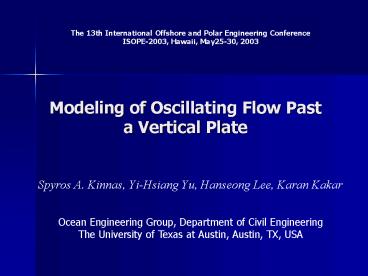Modeling of Oscillating Flow Past a Vertical Plate - PowerPoint PPT Presentation
1 / 23
Title:
Modeling of Oscillating Flow Past a Vertical Plate
Description:
Ocean Engineering Group, Department of Civil Engineering ... The 13th International Offshore and Polar Engineering Conference ... – PowerPoint PPT presentation
Number of Views:141
Avg rating:3.0/5.0
Title: Modeling of Oscillating Flow Past a Vertical Plate
1
Modeling of Oscillating Flow Past a Vertical Plate
The 13th International Offshore and Polar
Engineering Conference ISOPE-2003, Hawaii,
May25-30, 2003
- Spyros A. Kinnas, Yi-Hsiang Yu, Hanseong Lee,
Karan Kakar
Ocean Engineering Group, Department of Civil
Engineering The University of Texas at Austin,
Austin, TX, USA
2
Overview
- Introduction
- Governing Equations, Boundary Conditions and
Numerical Formulation. - Comparison of results from the 2D unsteady Euler,
Navier-Stokes Solvers with measurements. - Visualization of separated flow field.
- Summary and future work.
3
IntroductionMotivation Objectives
- Develop and validate a method for the prediction
of the effects of bilge keels on FPSO Hull
motion.
- Understand the physics of the unsteady separated
flow about the bilge keels of a hull subject to
roll motions, and predict the corresponding
hydrodynamic coefficients.
4
Motivation Objectives
- In this work, we apply and validate our model to
a bilge keel (vertical plate) subject to
horizontal sinusoidal inflow.
5
Literature Review
- Numerical Work
- Gentaz et al. 1997
- Korpus and Falzarano 1997
- Vassalos et al. 2000
- Yeung et al. 1992, 1996, 1998, 2000, 2002
- Experiments on Vertical Plate
- -Keulegan and Carpenter 1958
- -Sarpkaya and OKeefe 1995
6
Numerical FormulationGoverning Equation
- Non-Dimensional Navier-Stokes equations
- KC Keulegan-Carpenter number,
- Re Reynolds number,
7
(No Transcript)
8
Numerical Method
- Finite Volume Method
- Nis Lax-Wendroff Method for time
- Artificial dissipation (viscosity) only in the
case of Euler solver - SIMPLE Method for pressure correction
9
Euler and Navier-Stokes Solver
- Choi Kinnas 2000, Choi PhD thesis 2000
- -Development of Euler Solver and Navier-Stokes
solver. - Kakar MS thesis 2002
- Application of unsteady 2D Euler solver of flow
over bilge keels for FPSO hull motion.
- Euler Solver Applied artificial viscosity
- Navier-Stokes Solver Viscous terms
10
Force Calculation on the plate
- Morisons equation as follows Sarpkaya and
OKeefe (1995)
11
ResultsConvergence Study
At KC1
12
Convergence Study
At KC1
13
Force History comparison
14
Drag coefficient for a range of KC (0.5 lt KC lt 10)
15
Inertia coefficient for a range of KC (0.5 lt KC lt
10)
16
Streamline vorticity contour at 0T/4 for KC1
ES
NS
Streamline vorticity contour at 1T/4 for KC1
ES
NS
17
Streamline vorticity contour at 2T/4 for KC1
ES
NS
Streamline vorticity contour at 3T/4 for KC1
ES
NS
18
(No Transcript)
19
(No Transcript)
20
Summary
- A finite volume method was applied to the
solution of oscillating flow around a vertical
flat plate. The same plate and tunnel dimensions
as in the experiment of Sarpkaya and O'Keefe
have been used. - It was found, that either the Euler or the
Navier-Stokes solver produced force coefficients
and separated flow fields which were close to
each other and also close to the measurements,
especially for lower values of the
Keulegan-Carpenter number.
21
Summary
- For higher KC numbers, the viscous terms start to
be more important, and the effects of turbulence
may need to be taken into account. - The Euler solver has already been extended in the
case of FPSO hull sections, with and without
bilge keels, and some preliminary results have
been presented in Kinnas, et al., 12th Offshore
Symposium, Texas section of the SNAME, 2003.
22
Future Work
- Further investigations with different Re numbers
and KC numbers. - Continue with the extension in the case of FPSO
hull sections to study the effects of bilge keels.
23
The End































